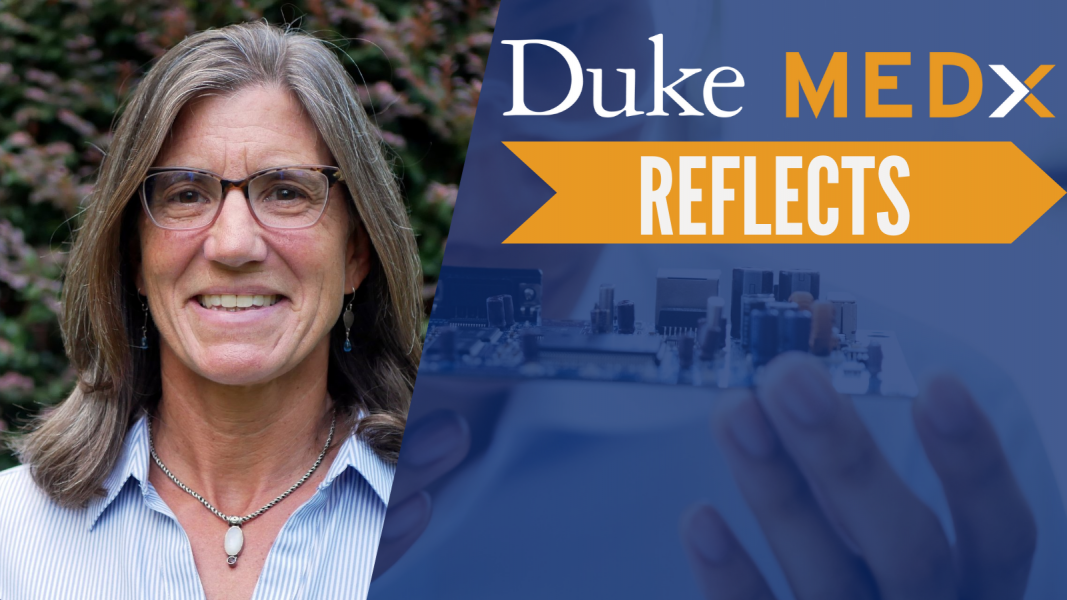MEDx Reflects: Exploring the medicine and engineering intersection with Kathy Nightingale

By Brittany Vekstein
Kathy Nightingale, PhD, is a Theo Pilkington Distinguished Professor of Biomedical Engineering at Duke's Pratt School of Engineering. Nightingale's research interest focuses on acoustic radiation force, a phenomenon associated with the propagation of acoustic waves in attenuating media.
Recently, MEDx supported the collaboration between Dr. Nightingale and Dr. Lisa Hobson-Webb, a Duke neurologist, through the MEDx Targeted Award in Biomechanics, to pursue a project, "Feasibility of 3D Shearwave Elasticity Imaging for Accessing Biomechanical Properties of Skeletal Muscle to develop an imaging system and a biomarker to facilitate diagnosis and therapeutic monitoring of muscle health." Nigthingale and Hobson-Webb are being awarded an NIH R01 grant to continue their research.
Why are you interested in research at the intersection of medicine and engineering?
I am an engineer and I have always loved to solve technical problems. Furthermore, being able to apply these skills in medicine by identifying unmet needs, proposing and developing solutions, and then implementing them, is intellectually stimulating. I find the most gratifying and rewarding part is seeing these solutions work to improve people’s quality of life.
Can you share more about your research work involving collaborations in Medicine?
Our group has pioneered the development of ultrasonic elasticity imaging methods that can quantify the stiffness of tissues. These have been translated to commercial ultrasound systems, and are being used clinically to stage liver fibrosis. Because our work is translational, we have many clinical collaborations. Currently, we have two main projects that are interdisciplinary. First, we are developing elasticity imaging as a biomarker for muscle disease and injury, and in this project we are collaborating with Dr. Lisa Hobson-Webb (Neurology), Dr. Laura Pietrosimone (Orthopaedic surgery) and Dr. Alison Toth (Orthopaedic surgery.) We are also developing ultrasonic elasticity imaging methods to provide imaging guidance for targeted prostate biopsy and focal therapy. We have just started a clinical trial for this project which has been developed in collaboration with Dr. Thomas Polascik (Urology), Dr. Rajan Gupta (Radiology), and Drs. Wen-Chi Foo and Jiaoti Huang (Pathology.)
What do you find to be the most beneficial part about this collaborations?
The impact of the project – by bringing engineers and clinicians together, we are able to assess the performance of our tools in the clinic and perform system design iterations based upon clinician feedback, which leads to more rapid and successful clinical translation of our tools.
How does having a clinical collaborator inform your work?
Clinician collaboration is critical throughout the entire project duration. Collaboration allows us to identify important problems, to brainstorm solutions, to provide feedback on prototype design, to help in the initial testing, and to perform clinical pilot studies - which ultimately lead to clinical adoption of our technologies.
Have your trainees benefited from your collaborations with Medicine faculty?
Absolutely – it is critical for our trainees to interact with our clinical collaborators. My students will often observe standard of care practices with our clinical collaborators prior to initiating our projects. Our clinical collaborators also typically serve as mentors, thesis committee members, and co-authors on publications with my trainees.
What's next for you?
We are currently initiating two clinical trials – one investigating elasticity imaging guidance for prostate cancer biopsy and focal therapy, and a second developing elasticity imaging biomarkers for muscle health.
Learn more about the Nightingale Lab
Read IEEE publication on "Qualification of Skeletal Muscle Fiber Orientation in 3D Ultrasound B-Modes"
The MEDx Reflects series highlights the many successes of collaborations from our affiliated faculty and MEDx investigators. We hope to inspire others to think about how collaborating across discplines can enhance research. If you are interested in sharing your story, please reach out to Brittany Vekstein (brittany.vekstein@duke.edu), communications specialist for MEDx.

